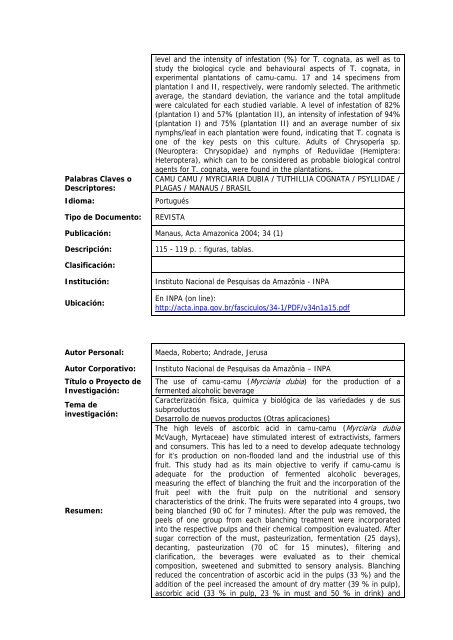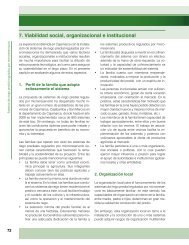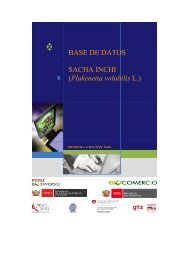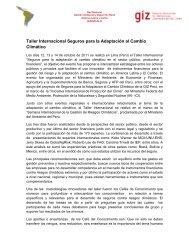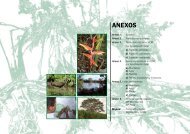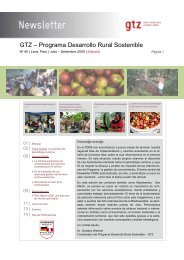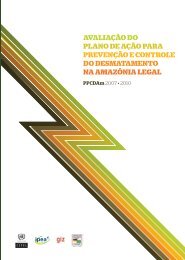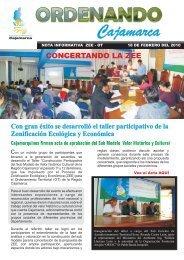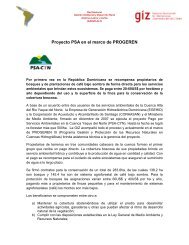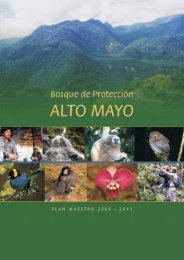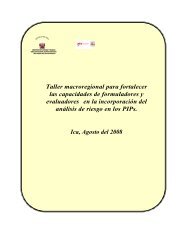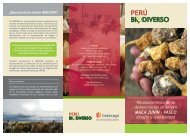Descárguelo aquí - PDRS
Descárguelo aquí - PDRS
Descárguelo aquí - PDRS
Create successful ePaper yourself
Turn your PDF publications into a flip-book with our unique Google optimized e-Paper software.
Palabras Claves oDescriptores:Idioma:Tipo de Documento:level and the intensity of infestation (%) for T. cognata, as well as tostudy the biological cycle and behavioural aspects of T. cognata, inexperimental plantations of camu-camu. 17 and 14 specimens fromplantation I and II, respectively, were randomly selected. The arithmeticaverage, the standard deviation, the variance and the total amplitudewere calculated for each studied variable. A level of infestation of 82%(plantation I) and 57% (plantation II), an intensity of infestation of 94%(plantation I) and 75% (plantation II) and an average number of sixnymphs/leaf in each plantation were found, indicating that T. cognata isone of the key pests on this culture. Adults of Chrysoperla sp.(Neuroptera: Chrysopidae) and nymphs of Reduviidae (Hemiptera:Heteroptera), which can to be considered as probable biological controlagents for T. cognata, were found in the plantations.CAMU CAMU / MYRCIARIA DUBIA / TUTHILLIA COGNATA / PSYLLIDAE /PLAGAS / MANAUS / BRASILPortuguésREVISTAPublicación: Manaus, Acta Amazonica 2004; 34 (1)Descripción:115 - 119 p. : figuras, tablas.Clasificación:Institución:Ubicación:Instituto Nacional de Pesquisas da Amazônia - INPAEn INPA (on line):http://acta.inpa.gov.br/fasciculos/34-1/PDF/v34n1a15.pdfAutor Personal:Autor Corporativo:Título o Proyecto deInvestigación:Tema deinvestigación:Resumen:Maeda, Roberto; Andrade, JerusaInstituto Nacional de Pesquisas da Amazônia – INPAThe use of camu-camu (Myrciaria dubia) for the production of afermented alcoholic beverageCaracterización física, química y biológica de las variedades y de sussubproductosDesarrollo de nuevos productos (Otras aplicaciones)The high levels of ascorbic acid in camu-camu (Myrciaria dubiaMcVaugh, Myrtaceae) have stimulated interest of extractivists, farmersand consumers. This has led to a need to develop adequate technologyfor it’s production on non-flooded land and the industrial use of thisfruit. This study had as its main objective to verify if camu-camu isadequate for the production of fermented alcoholic beverages,measuring the effect of blanching the fruit and the incorporation of thefruit peel with the fruit pulp on the nutritional and sensorycharacteristics of the drink. The fruits were separated into 4 groups, twobeing blanched (90 oC for 7 minutes). After the pulp was removed, thepeels of one group from each blanching treatment were incorporatedinto the respective pulps and their chemical composition evaluated. Aftersugar correction of the must, pasteurization, fermentation (25 days),decanting, pasteurization (70 oC for 15 minutes), filtering andclarification, the beverages were evaluated as to their chemicalcomposition, sweetened and submitted to sensory analysis. Blanchingreduced the concentration of ascorbic acid in the pulps (33 %) and theaddition of the peel increased the amount of dry matter (39 % in pulp),ascorbic acid (33 % in pulp, 23 % in must and 50 % in drink) and


